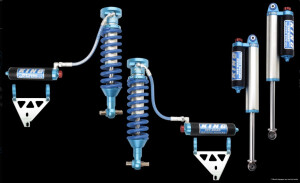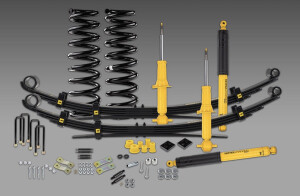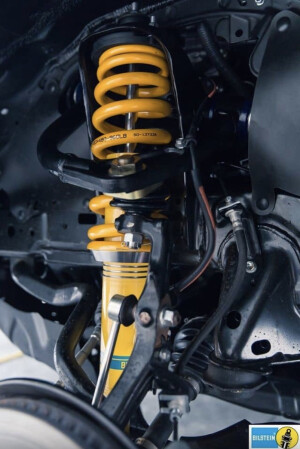
A suspension lift kit is a popular aftermarket upgrade that raises the vehicle's ride height and improves off-road performance. These kits typically include better springs and shocks, and allow for the fitment of larger tyres. The benefits for the Ranger include better clearance, improved approach and departure angles, and increased off-road capability.
However, a suspension lift kit can affect the vehicle's handling and ride quality, so it's important to choose the right kit for your needs and have it installed by a qualified professional.
- What it is: Replaces your shocks (dampers) and springs to lift the car slightly.
- Why you need it: Improved approach, ramp and departure angles, plus better load-carrying ability. The stock suspension isn’t designed for the constant load of accessories.
- Buying tips: Work out how much load you’ll have in the car at all times, such as the weight of bullbars, canopies and the like, and whether or not you’ll be likely to run at GVM (maximum weight). Then select the suspension. Also consider a GVM upgrade while you’re at it.
Here are four products we recommend. They’re intended as a starting point, to give you an idea of what’s available. We’ve included information on Ford Australia’s genuine accessories, in case you’d prefer to stick to OEM.
| Shock Design | Piston Bore | Rod Diameter | |
|---|---|---|---|
| Old Man Emu Nitrocharger Sport | Twin-tube | Not specified | 18mm |
| Bilstein B60 Shock Kits | Monotube | 60mm | 18mm |
| King Shocks Australia Performance Series | Remote reservoir | 63.5mm | 3/4-inch or 7/8-inch |
| Ironman 4x4 Foam Cell Pro Shock Kit | Twin-tube | 45mm | 20mm |
Ford Australia/ARB licensing agreement
Ford Australia has a licensing agreement with ARB. Order ARB accessories when you order a 2023 Ranger and they’ll be covered by Ford’s five-year warranty. So if you have a warranty issue, there’s no grey areas about which company is responsible.
If you order ARB accessories after purchase (through a Ford dealer), they’ll be covered by the remainder of the warranty period.
If you’d like to know more about the Ford/ARB partnership, check it out on the Ford website.
Old Man Emu Nitrocharger Sport
Pros
- Reputation for quality
- Tailored to vehicle’s intended use
- Vehicle-specific bushes
Cons
- Rubber bushes prone to wear
Bilstein B60 shock kits
Pros
- Australian made
- Reputation for reliability
- Rebuildable (model-dependent)
Cons
- Rubber bushes prone to wear
- Monotube design can give an overly harsh ride
King Shocks Australia Performance Series

Specifications:
- Shock design: Remote reservoir
- Piston bore: 63.5mm (2.5-inch)
- Rod Diameter: ¾-inch or 7/8-inch
Pros
- Rod ends, not rubber bushes
- Proven off-road racing pedigree
- Rebuildable and upgradable
Cons
- Nil
Ironman 4x4 Foam Cell Pro Shock Kit
Pros
- Decent mid-range offering
- Three valving options: Comfort, Performance, Professional
Cons
- Rubber bushes prone to wear
- Piston bore on the small side
2023 Ford Ranger buyers' guide: Suspension lift kits
What it is
A suspension lift kit replaces your shock absorbers and springs to lift the vehicle slightly, and to better cope with heavy loads. The shocks and springs work together as a matched set. If the manufacturer has done its job properly, you’ll end up with a ride better, both on- and off-road.
The springs give you the lift and bear all the weight of the vehicle. Heavier loads mean heavier springs (normally). OEM springs are more rated for a lightly loaded vehicle - they try to be all things to all people. That’s why OEM suspension tends to sag when you load it up, and why you need an upgrade kit.
The shocks are there to dampen the spring oscillations quickly, hence the name ‘dampers’. They stop the vehicle from bouncing like a pogo stick every time you go over a bump.
Any reputable accessories supplier will provide a shock/spring combination which has been designed to work as a unit. They’ll often have multiple kits depending on what load you typically carry and the type of 4WDing you do.
Why you need it
The stock suspension isn’t designed for the additional weight of accessories. Once you start loading up your fourbie, it’ll struggle. The ride will be horrible; it'll roll in corners, bottom out on the bump stops, and the shocks will fade quickly. Upgraded suspension will go a long way towards solving these issues.
Another benefit includes improved ground clearance, approach, ramp and departure angles. Even a small lift makes a huge difference to the drivability of a 4x4 in off-road conditions.
Buying tips
Work out how much all of your accessories weigh - bullbars, canopies, drawer systems, dual-battery systems, tow bar, and so on. Then add the weight of passengers plus personal gear. Then add some more for all of the extra bits and pieces you normally pack.
Add your final figure to the tare weight, also known as unladen weight. This will give the suspension supplier a rough idea of what suspension best suits your needs.
Talk to reputable suppliers and they should ask you a few questions about how you use the vehicle. If they understand exactly what you’re trying to achieve (a lift for off-road clearance, better handling, better towing ability, and so on) they’ll be able to choose the best damper/spring combo for you.
Shock absorber types
Shock absorbers generally fall into three different styles:
- Monotube
- Twin-tube
- Remote reservoir
Here’s a very quick and basic overview of each one.
1. Monotube
The oil and gas inside the shock are separated by a floating piston. This gives less foaming, meaning the shock will take longer to fade or ‘go off’, as it’s often termed. The downside? Monotube shocks can give a harsher ride than the other two styles.
2. Twin-tube
They have a tube within a tube. The inner tube has the piston, valving, rod and oil. The outer tube holds the gas in the gap between the two tubes.
There’s no piston between the oil and gas. So they can potentially mix and cause fade. The biggest advantage of twin-tube shocks is their compact size.
3. Remote reservoir
Generally speaking, these shocks are monotube shocks with one major modification. Instead of the floating piston (the one separating the oil and gas) being inside the monotube shock, it lives in a second cylinder.
This second cylinder is called a remote reservoir and sits adjacent to the main monotube body. The two are connected by a hydraulic hose.
The biggest advantage is a greater surface area and volume. There’s more oil inside the shock, plus a larger overall cooling surface, which means less heat build-up. And by taking the floating piston out of the main tube, the monotube can be more compact or offer increased wheel travel for the same overall length.
Remote reservoir shocks are the ultimate set-up for serious off-roaders. If you’ve ever had a set of shocks go off along a corrugated road, you’ll understand exactly why remote reservoir shocks are worth the money.
What to look for
A massively lifted 4WD might look great to some. Even on a stock vehicle, it’s tempting to push your suspension lift to the max. But there are both practical and legal limits on how high you can lift a vehicle. Legalities vary from state to state, so you’ll need to check these.
Just remember, the higher you lift a vehicle the less stable it’ll be. Start adding loads up high (like a rooftop tent), and chances are your pride and joy will handle like an old boat.
Then there’s the issue of suspension and drivetrain. Lifting a vehicle adds stress to universal joints, CV joints, tailshaft splines, and so on. Worst case, you’ll start snapping drivetrain components.
Look for reputable suppliers with proven track records in providing quality suspension kits. Companies like TJM, ARB, Bilstein and Dobinsons can advise you on the best damper/spring combination. And they’ll give you honest information on issues like the maximum recommended lift for your 4x4
Five things to look for in a damper
- Damper internal bore: The bigger the bore, the more oil it holds. The more oil it holds, the longer it’ll take to fade.
- Piston rod diameter: Larger diameter rods are simply stronger.
- Damper end mounts: Rod ends (also known as rose or swivel joints) are far superior to rubber or plastic bushes. Usually, the first thing to fail on a shock is the bushing. Rod ends avoid this issue by eliminating them altogether.
- Flexible boot: The piston should be protected from stone damage with a concertina rubber boot.
- Adjustment: Dampers with variable adjustment allow you to fine-tune them for optimal performance.
What about springs?
Springs are more difficult to choose. Springs have what’s called a ‘spring rate’, which in basic terms means the spring becomes firmer as the spring rate increases. A lot of things affect spring rate including material, thickness and number of coils/leaves. All you can do is trust the experts to provide you with the right springs - you’re paying for their expertise after all.
How we review products
4X4 Australia has been reviewing four-wheel drive vehicles and aftermarket products for more than 40 years.
When looking for the best accessories for your make and model of 4WD, there are some things essential to making sure you have the best off-roading experience.
When we compare products, here are some of the things we consider:
- Warranty
- Build quality
- Value for money
- Time and ease to set-up/install
- Weight
- Fit and finish
- How well it gets the job done
- What materials they’re made from
- Corrosion/UV resistance
- Coatings
- Compatibility with other accessories
- Compliance with ADRs and vehicle safety systems
- Country of manufacture
- Load ratings, to determine what's the best product across each price point.
We also consider user reviews and our own experience with these products to make sure our recommendations are for the best on the market.
Disclosure: When you buy through our links, we may earn a commission. We also include products that we do not earn a commission from.




COMMENTS